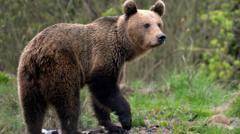A tragic bear attack in Romania's stunning mountain region has underscored the escalating tensions between wildlife and tourists. A motorcyclist parked at a well-known spot along the picturesque Transfagarasan road when he was fatally mauled by a bear, which subsequently dragged him down a steep ravine. Rescue team leader Ion Sanduloiu reported that the victim suffered severe injuries despite being equipped with a helmet and protective gear.
Officials are investigating the incident, and the bear involved remains alive for the time being. Although Romania boasts the largest brown bear population in the European Union, the frequency of dangerous encounters has led to renewed calls for stricter regulations and preventive measures. Recent studies by the Romanian environmental ministry estimate the bear population between 10,400 and 12,800, far exceeding the sustainable estimate of around 4,000 bears proposed by Mircea Fechet, a former environment minister.
Fechet suggested that simplifying laws could enable local authorities to act swiftly in managing bear encounters, including the euthanasia of bears that wander into populated areas. Additionally, the ministry's plans to create risk zone maps aim to balance wildlife conservation with public safety effectively.
However, conservationists, such as Gabriel Paun of the NGO Agent Green, argue that this tragic incident is not merely a consequence of overpopulation; instead, it reflects a failure in wildlife management. Paun emphasized that mismanagement is at the core of these issues—tourists' interactions with wild animals, insufficient actions by local authorities to guide bears back into their natural habitats, and the national government’s inadequate implementation of coexistence strategies are contributing factors.
Adding to the complexity of the situation is the ongoing threat to bear populations from climate change, habitat destruction, and legal hunting. The call for more stringent consequences for those who attract bears by stopping to feed them, as echoed by Sanduloiu, indicates a pressing need for systemic changes to prevent future tragedies.




















